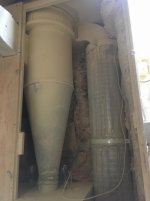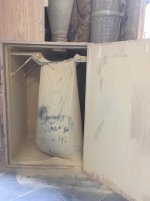craigclick
New member



My problem is with sanding dust. We recently bought a sanding calibrator and are two weeks into using the heck out of it. But a lot of the fines are being blown into the shop underneath my clean-out box and the upper back where there are some gaps between the cabinet and the wall.
We cleaned the filters before using the sanding machine. We do this by disconnecting them, taking them outside and knocking them against the ground and finally blowing compressed air through the pleats. Since then, you can see by the photos what's happening. Perhaps it's always happened, but hasn't been noticeable until now. We've always had the occasional problem of keeping the cyclone clean to allow the light sensor to pass.
When we turn on the blower there is always a huge puff of fines that come out of the vents below the cleanout box. There are no fines in the cleanout box. The door that encloses the bag section shuts against doorseal.
What am I doing wrong?





